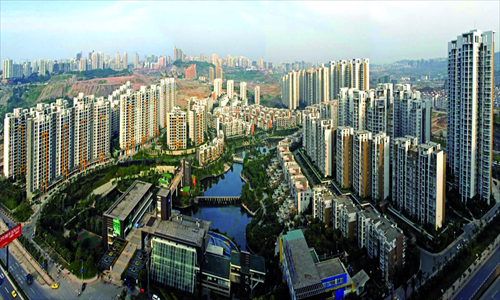Ghost town
Genghis Khan Plaza



The flight departing from Beijing at 6:50 am took me to Ordos, Inner Mongolia. While waiting for the shuttle bus to fill up for about half an hour, looking at the front of the two-storey airport gave me the impression that if you didn't know the city is one of the richest in China, with 1.5 million people, it could be mistaken for just a normal third-tier.
Fifteen minutes into the journey towards the downtown area, big construction sites started appearing on the semi-desert, one after another, and the scene instantly changed. Hundreds of unfinished buildings - mostly luxurious apartments and villas - looked experimental and even futuristic. I wondered who would fill all these empty houses and began to get a sense of why the city has acquired the name "ghost town of China." Then the bus finally arrived at what seemed to be one complex that was finished, although again basically empty.
It was the city hall and government headquarters in the new district of Kangbashi. The complex, consisting of three 11-storey buildings, has a somewhat oppressive feel to it. Giant sculptures of Genghis Khan and his men stand in the Genghis Khan Plaza, which a local reporter later said is the world's largest square, being around three kilometers in length.
The bus continued on its route for another half an hour. Passing some more construction sites, as well as rows of workers planting tall, full-grown trees in the loads, the bus finally arrived in downtown Ordos, which looked a lot more familiar in its architecture.
The current center of Ordos, a district named Dongsheng, is a clean and orderly area. Rumor has it, the city is in order because there are policeman at every intersection, who are not just there to pose. I observed a delivery van for some electronic store pass the stop line by about 10 centimeters at a red traffic signal. The police pulled over the car, asked for the license and gave the van a ticket for that alone. Meanwhile, school kids lined up as they waited for a bus without the presence of a teacher.
Cab drivers were also honest and did not try to cheat customers. This was something very different from what I experienced three days later when I arrived in Baotou, two hours northeast of Ordos and the largest city in Inner Mongolia.
Resource-abundant Ordos, whose name means "palaces" in the Mongolian language, is not a place for tourists.
If you ask locals, they will say the exact same places to visit - the Mausoleum of Genghis Khan and the new district of Kangbashi.
The Mausoleum of Genghis Khan, with an outrageous 100 yuan ($16) entrance fee, was probably the result of someone's idea to make a tourist spot in the area. The tomb contains some items Khan used, but not his actual body. When he died, this was buried or scattered without any markings, according to his will. The tour of the mausoleum took less than an hour, of which about 20 minutes of that time was devoted to climbing up hundreds of stairs.
Some might find this disappointing, and might want to take advantage of the horses for riding and yurts that are located near the mausoleum. For myself though, the disappointment brought me back to Kangbashi, in order to look more closely at what might be the microcosm of Chinese urban planning.
The Genghis Khan Plaza does boast some exquisite, experimental architecture and cost a fortune to build. The square is also apparently home to two of the world's largest horse statues.
Although not quite as ambitious, the Ordos Library, which resembles a stack of huge books on a bookshelf, the Opera House, which looks like a hat that belongs to a minority woman, and the Ordos Museum, a symbolic image of "the ever rising sun on the grassland," are all worth a look.
Even more ambitious will be Ordos 100, a giant construction project, unrealized yet, led by artist Ai Weiwei. It involves the construction of 100 villas designed by 100 architects from many different countries.
One might wonder why they decided to build a whole new city instead of improving the old one. The old part of the city did contain many buildings with "chai" (to be demolished) marked on them. One local said that is because it is probably easier to build a whole new city rather than to work with the old buildings.
The city, including the old and new areas, seems to be an experiment of urban planning in China. Its future is therefore a cause of both curiosity and concern.
It has yet to shed its name of the "ghost town of China," but people here remain ambitious about the future. "The city is being built in order. Government buildings and residential housing first and now schools and shopping malls," said the local reporter. "My parents will move to a house I bought in the new town when it's done," added the man who had been driving me around Ordos during my trip.